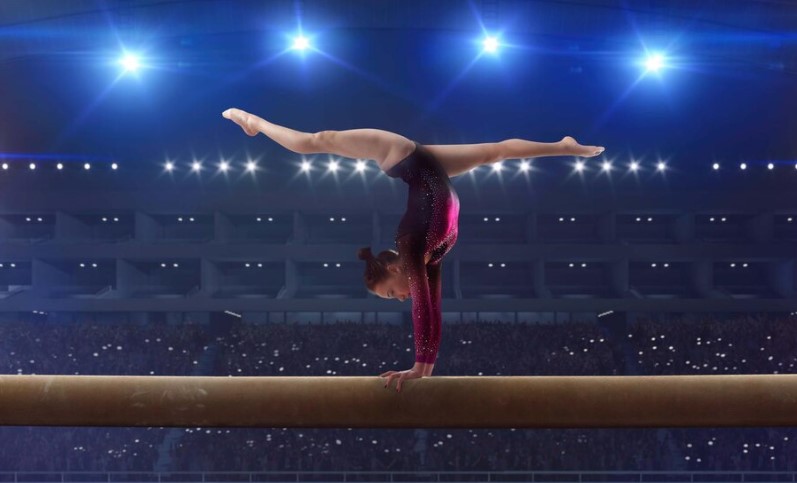Rhythmic Gymnastics: Grace, Beauty, and Athleticism Combined

Rhythmic gymnastics is a beautiful and athletic sport that combines elements of ballet, gymnastics, dance, and apparatus manipulation. Though lesser known than artistic gymnastics, rhythmic gymnastics is growing in popularity and visibility worldwide. This article will provide an introduction to rhythmic gymnastics, covering its history, rules, scoring, and required elements. We’ll also highlight some of the top athletes and competitions in the sport.
A Brief History of Rhythmic Gymnastics
Unlike artistic gymnastics, which has ancient roots, rhythmic gymnastics is a relatively modern sport. It emerged in the late 19th century out of innovations in physical education systems that emphasised grace and movement. Rhythmic gymnastics began being performed as a competitive sport in the 1940s and 1950s in the Soviet Union.
The International Gymnastics Federation (FIG) officially recognized rhythmic gymnastics as a sport in 1961. It was initially open only to individual competitors. Group rhythmic gymnastics was officially added in the 1970s. Rhythmic gymnastics debuted at the 1984 Olympics in Los Angeles and has been part of the Summer Games ever since.
Over time, rhythmic gymnastics has grown beyond its Eastern European origins. While Russia and other former Soviet states still dominate, rhythmic gymnastics is gaining popularity in Asia, Western Europe, and the Americas. The sport continues evolving as more countries develop programs and competitive opportunities expand.
Rules and Scoring
Rhythmic gymnasts perform complex routines blending dance and acrobatics while manipulating hand apparatus like balls, clubs, hoops, and ribbons. Routines last between 1:15 to 1:30 minutes for individuals and 2:00 to 2:30 minutes for groups.
Scoring is based on both difficulty of elements and execution quality. The Difficulty score evaluates things like complex apparatus handling and dance moves. Execution scores technique, artistry, synchronisation (for groups), and other factors. Major deductions occur for drops, collisions, forgotten elements, etc. The gymnast/group with the highest total score wins.
Key elements in rhythmic gymnastics routines:
| Element | Description |
|---|---|
| Apparatus handling skills | Tosses, rolls, rotations, etc. |
| Balances and pivots | Static positions requiring control |
| Jump and leap sequences | Combinations demonstrating agility |
| Flexibility movements | Contortions and stretches |
| Acrobatic moves | Rolls, walks, pivots, etc. |
| Dance and arm movements | Graceful motions in time with music |
Routines require careful choreography to seamlessly blend required elements with music and flowing transitions.
Prominent Competitions
The two major international competitions in rhythmic gymnastics are the World Championships and Olympics.
World Rhythmic Gymnastics Championships – Held annually since 1963 (biannually before 1987). Open to individual gymnasts and groups. Often a preview for next year’s Olympic competition.
Olympics – Held every four years since 1984. Regarded as the pinnacle for rhythmic gymnasts to showcase their talents. 30 gymnasts qualify in the individual event and 8 teams of 5 gymnasts qualify in the group event.
Other important competitions include:
- World Cup series events
- European Championships
- Pacific Rim Championships
- Pan American Games
- World Games
Rhythmic gymnastics is not currently part of the NCAA collegiate system. Athletes tend to peak in their late teens and retire from elite competition in their early to mid 20s.
Notable Rhythmic Gymnasts
Many brilliant rhythmic gymnasts have left their mark on the sport. Here are some all-time greats:
Alina Kabaeva (Russia) – The most decorated rhythmic gymnast ever with 2 Olympic medals and 14 World Championship medals. Known for her extreme flexibility and exquisite artistry. Retired in 2007.
Yevgeniya Kanayeva (Russia) – Won 2 consecutive Olympic all-around gold medals in 2008 and 2012. She has a record 23 World Championship medals. Retired after the 2012 Olympics.
Yana Kudryavtseva (Russia) – At just 15, she won 3 gold medals at the 2016 Olympics. The first rhythmic gymnast to win multiple individual apparatus golds at a single Olympics.
Liubov Charkashyna (Belarus) – Olympic all-around bronze medalist in 1996 and 2000. First non-Russian to become World Champion. Known for her innovative apparatus handling.
While Russians still dominate, gymnasts like Liubov Charkashyna show the sport is opening up beyond Eastern Europe. Up-and-coming rhythmic gymnasts like Linoy Ashram (Israel), Kaho Minagawa (Japan), and Evita Griskenas (USA) display the bright future ahead.
To conclude, rhythmic gymnastics is an awe-inspiring combination of athletic mastery and graceful artistry. Gymnasts must develop tremendous strength, flexibility, balance, and control to manipulate apparatus while completing challenging acrobatic elements. Routines are as beautiful as ballets but performed with the power and precision of top athletes.
As rhythmic gymnastics gains more exposure worldwide, appreciation continues growing for the skill and dedication these talented gymnasts possess. Their breathtaking performances will no doubt inspire future generations of young gymnasts to pursue this unique Olympic sport.